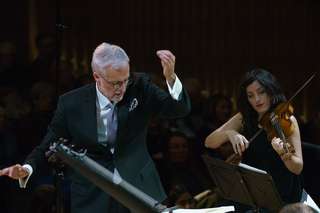|
Back
Another beguiling program from Tafelmusik Toronto
Trinity-St Paul's Centre - Jeanne Lamon Hall
11/29/2017 - & November 30*, December 1, 2, 3, 2017
Four Weddings, a Funeral, and a Coronation:
Jean-Baptiste Lully: Ballet from Xerxès
Henry Purcell: Symphony and Airs from Ode From hardy climes
John Blow: God spake sometimes in visions
Johann Pachelbel: Canon and Gigue for three violins and continuo
Marc-Antoine Charpentier: Messe des morts, H. 10
George Frideric Handel: Overture and chorus “S'accenda pur” from Il parnasso in festa
The Tafelmusik Baroque Orchestra and Chamber Choir, Elisa Citterio (orchestra director), Ivars Taurins (choir director)

I. Taurins & E. Citterio (© Jeff Higgins)
With this program titled Four weddings, a funeral, and a coronation the Tafelmusik Baroque Orchestra and its choir have once again come up with a program that avoids overplayed repertory (with one exception) and delivers a number of historical vignettes.
It opened with wedding music composed by Jean-Baptiste Lully for the marriage of King Louis XIV and the Spanish princess Maria Theresa in 1660. Cavalli’s opera Xerxes was performed then, with the addition of ballet sequences composed by Lully. The resulting suite of eight numbers, featuring flutes and percussion, is piquant and lively, especially the one titled “Les François et Espagnols”.
The second wedding music was from Henry Purcell’s ode From hardy climes and dangerous toils of war composed for the 1683 wedding of England’s Princess Anne (the future queen) and Prince George of Denmark. We heard only the introductory symphony plus instrumental airs, all displaying the 24-year-old composer’s fluent mastery. The theorbo gives the piece a rich plangency.
Just two years after that marriage Anne’s father James was crowned king, and John Blow composed the anthem “God spake sometime in visions” from Psalm 89. The chosen text, referring to King David, hammers home the concept of divine right that was soon to be challenged when, after just two years on the throne, James was forced off and a constitutional monarchy was established. The choral work’s eight parts give it an intricate delicacy. Its concluding “allelujah” is gentle compared to the mighty choruses to be composed later by Handel. Blow’s piece was again used at the coronation of King George II in 1727 when the famous Handel anthems were introduced. They must have decisively overshadowed Blow’s work.
Not composed for any wedding (as far as is known) but used frequently at modern day weddings is Johann Pachelbel’s ever-popular Canon, played by three violins plus a continuo of organ, cello and theorbo, all very nicely modulated - and then followed by its lively Gigue.
What turned out to be the weightiest work of the evening was the funeral music, Marc-Antoine Charpentier’s Messe des morts, composed in 1695 for the funeral of the Duke of Luxembourg, Marshal of France. Apparently the funeral was sumptuous in its solemnity, as is the music with its stately, gracious Kyrie, followed by alternating sections for soloists or chorus and occasionally vocal duets or trios. There is a degree of a bounce in the Tuba mirum and a moment of grandeur in the Sanctus before the simplicity of the Agnus Dei. The work is about 35 minutes long.
The concert concluded with the overture and a chorus from Handel’s Il parnasso in festa, composed for the 1743 wedding of another Princess Anne, daughter of George II, who married the future William V of the Netherlands. The overture is like a brief symphony in three sections, with Handel at his lilting best in the opening, before a section with abrupt contrasts in tone, leading to a racing finish. The chorus “S’accenda pur di festa” has brief solos for Apollo (an alto role) and two of his muses, Clio and Calliope. When Anne moved to the Netherlands she promoted the music of Handel, and one can understand why as her wedding music is a celebratory gem - and a fine conclusion to the performance.
For the program’s three choral works 10 of the choirs 24 members were called upon for solo duties, all well chosen, some outstanding. Numerous microphones were in evidence so I suspect we’ll see yet another recording from the organization. The Charpentier mass will certainly be the centrepiece.
Michael Johnson
|